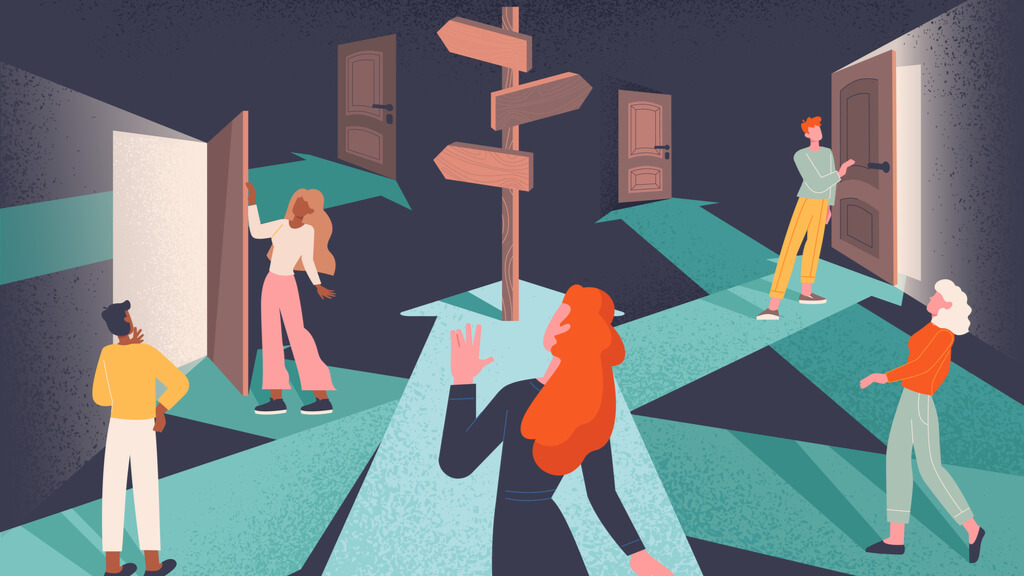As approaches to working and living diversify, what it takes to find our way has shifted from following prescribed paths to blazing new ones.
The Art Of Wayfinding: No One Size Fits All
As approaches to working and living diversify, what it takes to find our way has shifted from following prescribed paths to blazing new ones.

We’ve all experienced it in one context or another. The low stakes yet awkward moment when you enter an unfamiliar space and aren’t quite sure what to do next. Maybe you walk into a restaurant and wonder: “Do we seat ourselves or wait to be seated?”
Or you enter a building and ask, “Where do I go next?” The placement of signs in a lobby or the choice to have a receptionist or maître d when we enter a space is the little-known but important purview of wayfinding professionals.
When wayfinders do their job well, we don’t notice it. We turn the corner in the labyrinth of hospital hallways and take for granted that there is a sign on the wall or hanging from the ceiling in just the right place to point the way to the lab or x-ray.
Or we come over a rise on a hiking trail and see the white spray-painted strike on a tree just before we would have started to wonder if we’d wandered off track. If there is a “right” way to get from point A to point B, wayfinders help us to find it.
Whether or not we would use that term for it, we also rely on organizational and cultural wayfinders to guide us on our professional and personal journeys. Onboarding processes, training programs, handbooks and other guidance help people to orient themselves and find pathways forward in their careers.
Advisors, administrators and educators provide wayfinding services for learners. Cultural norms, traditions and rituals provide wayfinding clues for how we engage with our friends, families and in our communities.
Or do they?
There was a time (real or imagined) when many people believed they could rely on leaders and other cultural wayfinders to create trustworthy systems to help people live a good life. The primary task of adulthood was to choose the “right” path and follow it.
This generally involved making a few key decisions early in life about where you wanted to work and who wanted to marry, then simply follow the rules and move along the path to success—for yourself and the next generation. Sure, unexpected challenges might block the path or require detours along the way, but all you needed to do was get back on track and start again.
Times have certainly changed.
As approaches to working and living diversify, what it takes to find our way has shifted from following prescribed paths to blazing new ones. Wayfinding is about exploring new possibilities in uncharted territory.
Rather than rely on employers, institutions or systems to tell us where to go and what to do, many of us now view careers and lifestyles as ours to imagine and bring to life. This is great news, especially for people who were marginalized or otherwise not well served by the systems and frameworks that defined success in the past.
It also changes our approach from following a set path to developing the curiosity and wayfinding spirit we need to consider all of the possible paths ahead of us and the willingness to explore new ways of working and living.
This is the opportunity and the challenge we all face in a world where we can no longer take for granted that there will be a sign or a signal around the corner to guide our way.
Like artists and other creatives, wayfinding in times of disruptions, uncertainty and change involves a continual process of learning in action and a willingness to continually make sense of new circumstances and discern what is possible as we gather new information and consider new paths in practice.
That way, rather than be forced to adapt to existing paths that may or may not align with who we are and how we want to live, we can create our own maps and follow the signs and signals that are relevant to the careers we hope to have and the lives we choose to live.
Of course, like entering any new terrain, this can be exciting if we engage with wayfinding as an invitation to curiosity and exploration—or daunting if we enter with fear and trepidation. It is also easier said than done. That’s why learning to embrace the unknown and enter uncharted territory with a wayfinding mindset is a 21st century imperative.
Joan P Ball is an educator, transition expert and author of Stop, Ask, Explore. Learn to Navigate Change in Times of Uncertainty (Kogan Page).
Thanks for signing up to Minutehack alerts.
Brilliant editorials heading your way soon.
Okay, Thanks!